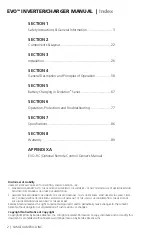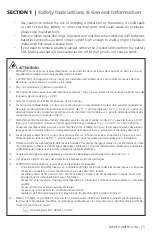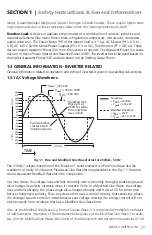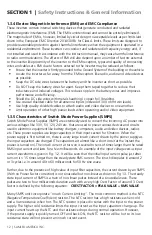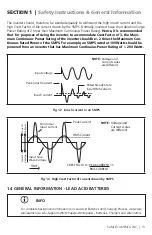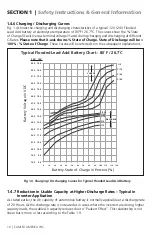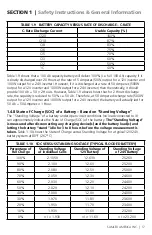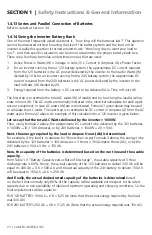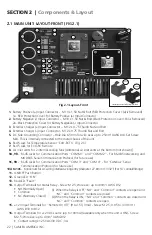
8 | SAMLEX AMErICA INC.
•
electric Motors:
At the moment when an electric motor is powered ON, the rotor is
stationary (equivalent to being “Locked”), there is no “back EMf” and the windings draw
a very heavy starting current (Amperes) called “Locked rotor Amperes” (LrA) due to low
DC resistance of the windings. for example, in motor driven loads like Air-conditioning and
refrigeration Compressors and in Well Pumps (using Pressure Tank), LrA may be as high as
10 times its rated full Load Amps (fLA) / Maximum Continuous running Power rating. The
value and duration of LrA of the motor depends upon the winding design of the motor
and the inertia / resistance to movement of mechanical load being driven by the motor. As
the motor speed rises to its rated rPM, “back EMf” proportional to the rPM is generated
in the windings and the current draw reduces proportionately till it draws the running fLA /
Maximum Continuous running Power rating at the rated rPM.
•
transformers (e.g. isolation transformers, Step-up / Step-down transformers,
Power transformer in Microwave oven etc.):
At the moment when AC power is
supplied to a transformer, the transformer draws very heavy “Magnetization Inrush
Current” for a few millisecs that can reach up to 10 times the Maximum Continuous
rating of the Transformer.
•
Devices like infrared Quartz halogen heaters (also used in Laser Printers) / Quartz
halogen Lights / incandescent Light bulbs using tungsten heating elements:
Tungsten has a very high Positive Temperature Coefficient of resistance i.e. it has lower
resistance when cold and higher resistance when hot. As Tungsten heating element will be
cold at the time of powering ON, its resistance will be low and hence, the device will draw
very heavy Starting Surge Current with consequent very heavy Starting Surge Power with a
value of up to 8 times the Maximum Continuous running AC Power.
•
AC to DC Switched Mode Power Supplies (SMPS):
This type of power supply is used
as stand-alone power supply or as front end in all electronic devices powered from Utility
/ Grid e.g. in audio/video/ computing devices and battery chargers (Please see Section
4 for more details on SMPS). When this power supply is switched ON, its internal input
side capacitors start charging resulting in very high Inrush Current for a few millisecs
(Please see fig 4.1). This inrush current / power may reach up to 15 times the Continuous
Maximum running Power rating. The inrush current / power will, however, be limited by
the Starting Surge Power rating of the AC source.
Power Factor, (PF):
It is denoted by “Pf” and is equal to the ratio of the Active Power (P) in
Watts to the Apparent Power (S) in VA. The maximum value is 1 for resistive types of loads
where the Active Power (P) in Watts = the Apparent Power (S) in VA. It is 0 for purely inductive
or purely capacitive loads. Practically, the loads will be a combination of resistive, inductive and
capacitive elements and hence, its value will be > 0 <1. Normally it ranges from 0.5 to 0.8.
Load:
Electrical appliance or device to which an electrical voltage is fed.
Linear Load:
A load that draws sinusoidal current when a sinusoidal voltage is fed to it. Examples
are, incandescent lamp, heater, electric motor, etc.
non-Linear Load:
A load that does not draw a sinusoidal current when a sinusoidal voltage is
fed to it. for example, non-power factor corrected Switched Mode Power Supplies (SMPS) used
in computers, audio video equipment, battery chargers, etc.
resistive Load:
A device or appliance that consists of pure resistance (like filament lamps, cook
tops, toaster, coffee maker etc.) and draws only Active Power (Watts) from the inverter. The
inverter can be sized based on the Active Power rating (Watts) of the resistive Load without
creating overload (except for resistive loads with Tungsten based heating element like filament
SECTIOn 1 |
Safety Instructions & general Information


